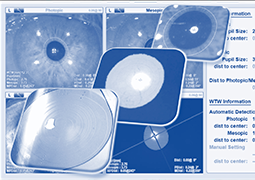Aims: This pilot study aims to present a novel method for quantitatively assessing the decentration of a trifocal intraocular lens (IOL) (Acrysof IQ PanOptix®) relative to three ocular reference points: the visual axis (first Purkinje reflex), the photopic pupil center, and, for the first time, the corneal geometric center. Additionally, the study evaluates the influence of postoperative chord mu, chord alpha, and the distances of the IOL from these reference points on visual outcomes.
Materials and Methods: This retrospective, observational study included 18 eyes from 12 patients who underwent cataract surgery with PanOptix® IOL implantation. Postoperative IOL positioning was assessed using OPD-Scan III images, applying a novel approach that combines diffuse frontal and retroillumination views. Distances between the IOL center and three ocular reference points, including the corneal geometric center, were measured, and postoperative patient satisfaction was evaluated using the Catquest-9SF survey. Statistical analyses were performed to assess correlations among reference distances, chord measurements, and visual performance.
Results: The study found that in 72.2% of cases, the IOL center was closer to the visual axis than to the corneal geometric center. A greater distance between the IOL and the corneal geometric center was associated with an improved near-vision area under the visual acuity defocus curve. However, no significant correlations were found between chord mu or chord alpha and visual outcomes, patient symptoms, or satisfaction.
Conclusion: This new approach to determining IOL centration proved practical, showing that the PanOptix® IOL tends to remain close to the visual axis over time, aligning with the surgeon’s initial placement. No clear associations were found between chord mu, chord alpha, or most IOL distances (except the distance to the corneal geometric center) and visual quality or patient satisfaction. Further studies are needed to confirm these findings and to refine selection criteria for multifocal IOLs to enhance patient satisfaction and visual outcomes.

